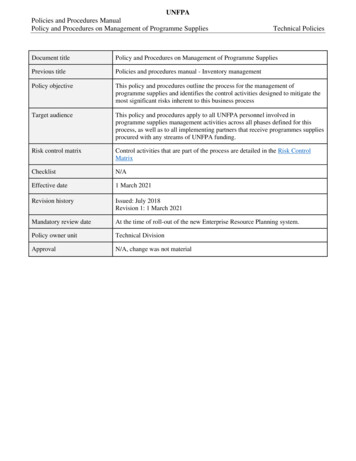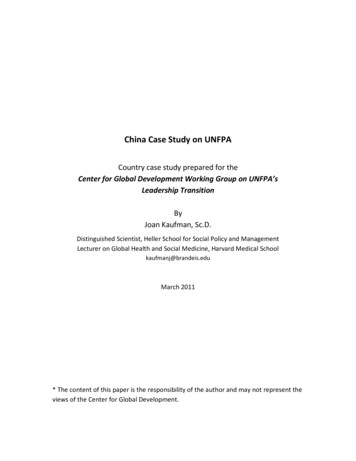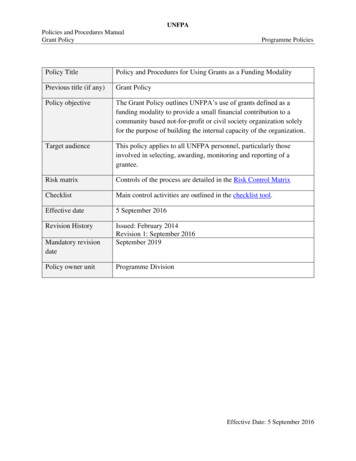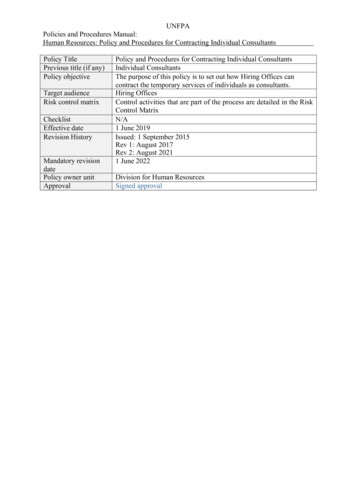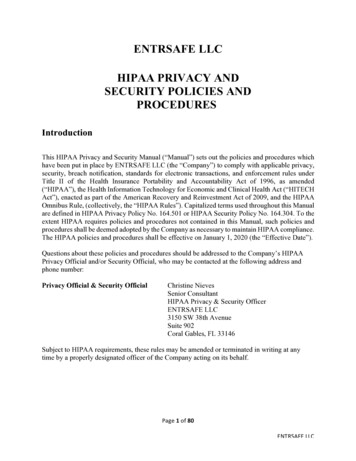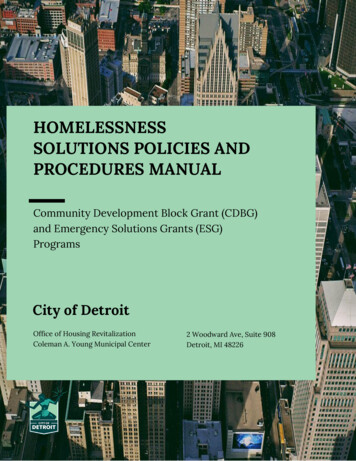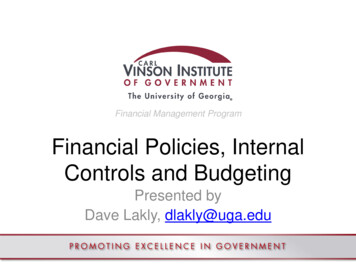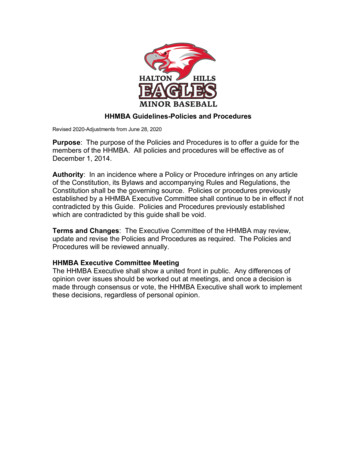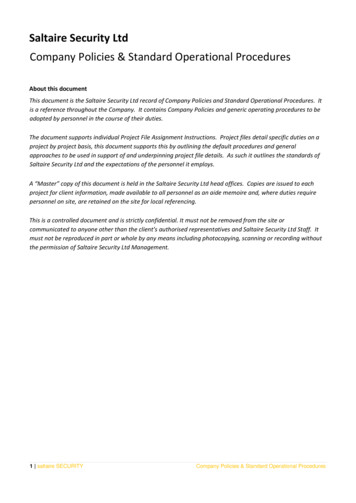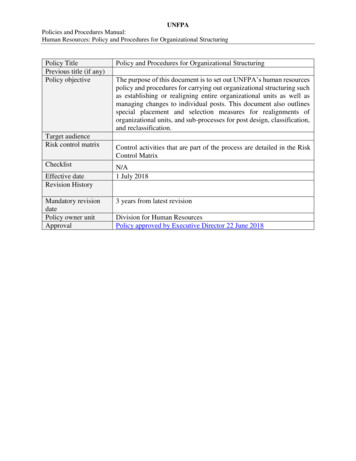
Transcription
UNFPAPolicies and Procedures Manual:Human Resources: Policy and Procedures for Organizational StructuringPolicy TitlePrevious title (if any)Policy objectiveTarget audienceRisk control matrixChecklistEffective dateRevision HistoryMandatory revisiondatePolicy owner unitApprovalPolicy and Procedures for Organizational StructuringThe purpose of this document is to set out UNFPA’s human resourcespolicy and procedures for carrying out organizational structuring suchas establishing or realigning entire organizational units as well asmanaging changes to individual posts. This document also outlinesspecial placement and selection measures for realignments oforganizational units, and sub-processes for post design, classification,and reclassification.Control activities that are part of the process are detailed in the RiskControl MatrixN/A1 July 20183 years from latest revisionDivision for Human ResourcesPolicy approved by Executive Director 22 June 2018
UNFPAPolicies and Procedures Manual:Human Resources: Policy and Procedures for Organizational StructuringTABLE OF ing an Organizational Unit Structuring Proposal32.Implementation of approved office structuring5Establishment of new organizational unit5Restructure of existing organizational unit5B.MAKING INDIVIDUAL STRUCTURAL CHANGES7C.ORGANIZATIONAL STRUCTURING SUB-PROCESSES81.Post design82.Post classification and reclassification process83.Requests initiated by heads of offices/ divisions94.Implementation of post classification and post reclassification decisions10Implementation of new post classification or post reclassification ofunencumbered posts10Implementation of the post reclassification of an encumbered post11IV.OTHER - Summary of Referenced Policies and Tools12V.FLOWCHARTS14VI.RISK MATRIX16
UNFPAPolicies and Procedures Manual:Human Resources: Policy and Procedures for Organizational StructuringI.PURPOSE1.The purpose of this document is to set out UNFPA’s human resources policy and proceduresfor carrying out organizational structuring such as establishing new units (includingdecentralized offices) or realigning entire organizational units as well as managing changesto individual posts.2.The purpose of organizational structuring is to further the mandate of the organization byensuring that it is able to meet organizational needs and efficiently uses its resources. It isnecessary to ensure that UNFPA’s structure is at all times aligned with its goals and missionand is to be carried out with the utmost integrity. It is not a tool to address performance orinter-personal issues.3.This document also outlines the implementation of structural changes including specialplacement and selection measures for realignments of organizational units and the subprocesses involved in post design, classification and reclassification.4.For the purposes of this policy, an organizational unit is defined as a division, branch, officeand unit at headquarters, and outside headquarters as a regional office, a sub-regional office,a country office, and a decentralised office.5.For the purpose of this policy, a head of unit refers to the representative, division director,regional or sub-regional director, country director or the Chief of Operations (or thedelegated officer), as appropriate.II.6.POLICYThe policy outlines the conditions and procedures for structuring organizational units andidentifies control actions to mitigate potential risks related to the process as summarisedbelow.(a) Heads of unit must obtain approval from the Deputy Executive Director (Programme)(DED-P) for offices in the field, and Deputy Executive Director (Management) (DEDM) for HQ and offices under the Office of the Executive Director, and endorsementfrom their relevant director, to initiate the process of organizational structuring in casesin which this process is not initiated directly by the Executive Director.(b) Normally organizational structuring will be carried out in conjunction with the countryor regional programme, budget process, or changes in funding. Examples of drivers thatmay result in the need to create or restructure an organizational unit are provided in thefollowing section: Procedures.1Effective June 2018
UNFPAPolicies and Procedures Manual:Human Resources: Policy and Procedures for Organizational Structuring(c) Any unit requesting organizational structuring must use the standardized documentsavailable in the “Organizational Structuring Administrative Tool”.(d) An organizational structuring proposal must be cleared by the head of unit and endorsedby the relevant director. The Division for Human Resources will initiate the clearanceprocess and ensure all offices that need to be involved are consulted.(e) All organizational structuring proposals are approved by the Deputy Executive Director(Programme) (DED-P) for offices in the field, and Deputy Executive Director(Management) (DED-M) for HQ and offices under the Office of the Executive Director(f) For new organizational units, posts are filled in accordance with the relevant provisionsof the policy on personnel. In the case of a restructuring, posts are filled utilising thespecial process for placement and selection outlined in this policy.(g) In those cases where changes involve less than ten percent and no more than five of theposts within the unit, such cases may normally be managed on an individual basis andan organizational unit structuring proposal may not be required. However, the Director,DHR, may determine that it does entail a restructuring of the organizational unit, andthat the corresponding process may need to be initiated.(h) Posts are designed, classified or reclassified, and filled in accordance with the subprocesses outlined in this policy.(i) Post design must be formalized in a generic or non-generic job description. A genericjob description is the preferred option and should be used where feasible.(j) Posts are classified / reclassified by external classification services utilizing the masterstandards established by the International Civil Service Commission. Post classification/ reclassification is required when a job description substantively differs from an existinggeneric or non-generic job description.(k) For any organizational structure with implications on office space, the Policy for RealEstate Management at Headquarters Policy or Policy for Real Estate Management forField Offices and relevant security measures must be followed.III.PROCEDURESA. ESTABLISHING OR RESTRUCTURING ORGANIZATIONAL UNITS7.To support achievement of UNFPA’s strategic objectives, the organization needs an optimaldesign for the organization as a whole, for each organizational unit, and for every individualpost. Organizational changes can result in the need to modify the organizational structure byestablishing or restructuring an organizational unit, or by changing some individual posts.Examples of organizational drivers that may result in the need to create or restructure an2Effective June 2018
UNFPAPolicies and Procedures Manual:Human Resources: Policy and Procedures for Organizational Structuringorganizational unit could include, but are not limited to:(a)(b)(c)(d)(e)(f)8.Changing programme requirements;Expiration of finite mandates (such as programme cycles or technical assistanceprogrammes);New country programme cycles and priorities;Post conflict or emergency situations;Changes in budget and funding;Audit findings or the outcome of investigations.An organizational structuring process may be initiated by the Executive Director.Alternatively, approval to initiate the process to restructure an organizational unit or open anew decentralized office must be sought by the head of the organizational unit (“head ofunit”) and endorsed by the responsible director using the “Request for Initiation ofOrganizational Structuring”. For establishment of a new organizational unit, since there isno head of unit, approval to initiate the process must be sought by the relevant director.Approval is provided by the Deputy Executive Director (Programme) (DED-P) for offices inthe field, and Deputy Executive Director (Management) (DED-M) for HQ and offices underthe Office of the Executive Director.1. Preparing an Organizational Unit Structuring Proposal9. The UNFPA representative has delegated authority to establish a decentralized office as partof programmatic activity in a workplan once the process has been endorsed by theresponsible director and approved by the relevant Deputy Executive Director. All relevantprogramme, real estate/facilities, and security policies apply and staffing of the office mustfollow the procedures outlined in this policy.10. All the forms, templates, and other documentation required for organizational structuring,including the “Initiation Request Template”, are contained in the “Organizational StructuringAdministrative Tool”.11.Once the request to initiate an organizational structuring process has been approved, aproposal outlining the recommended new structure must be prepared by the relevant head ofunit with advice and support from the Human Resources Strategic Partner responsible forHeadquarters or the relevant Region, respectively.12.The organizational unit structuring proposal must be prepared using the “Initiation RequestTemplate” and will include:(a)The purpose of the unit structuring proposal (i.e. creation of a new organizational unitor substantial restructure of an existing organizational unit);(b)Location of the unit;3Effective June 2018
UNFPAPolicies and Procedures Manual:Human Resources: Policy and Procedures for Organizational Structuring(c)A succinct business case supporting the need to create a new unit or substantiallyrestructure an existing unit, unless the structuring request has been initiated by theExecutive Director. This includes the circumstances that have resulted in thisrequirement, an outline of the main outputs to be delivered by the unit and anexplanation of how the proposed structure better supports the organization’s StrategicPlan, and the country programme if applicable, and how it contributes to efficient useof resources;(d)An organizational chart including all proposed posts, titles, grade levels, post numbers,and funding source for each post as well as reporting lines between the different posts.The organizational chart should contain both staff posts as well as other proposedpositions utilising the service contract and/or the UN volunteer modality that may beused on a medium-term basis of approximately one year or longer. The organizationalchart needs to demonstrate a logical, consistent, and coherent structure based onbusiness needs. Careful consideration must be given to the appropriate contractualmodality and funding source to be used for each position on the basis of the nature andexpected duration of the associated tasks. Further guidance can be found in the Policyon Personnel: Types of functions and corresponding contracts, the ResourceManagement Policy, the UNFPA Cost Recovery Policy, and associated guidancenotes.(e)When restructuring an existing organizational unit rather than the creation of a newunit, an organigram of the existing structure including all posts (including encumberedvacant and new), titles, post numbers, funding source for each post, current grade level,and reporting lines, as well as other positions utilising a non-staff contractual modalitythat have been used on a medium-term basis;(f)An assessment of the financial sustainability of the organizational structure, includingcost implications, cost classification and how funding will be provided. To obtainfinancial clearance, an “Organizational Unit Structuring Financial Template” mustalso be completed and attached. Further information and tools for developing andassessing the financial sustainability of the proposal can be found in the GuidanceNote on Financial Assessment for Proposals for Office Realignments. To the extentpossible, post costs should be shifted away from Regular Resources to OtherResources (for further details please refer to Guidance Note for Allocating Post CostsAcross Funding Sources).13.Restructuring proposals will be cleared by the head of the requesting unit and endorsed bythe responsible director. For organizational units that do not report to a director and insteadreport to the Executive Director or DED-M, the proposal will be signed off by the head ofthe requesting unit and submitted to the DED-M, who can then directly approve it. Forestablishment of a new organizational unit, since there is no head of unit, the proposal wouldbe signed off by the relevant director.14.Once the proposal is finalized it is uploaded by the head of unit, director, or Deputy Executive4Effective June 2018
UNFPAPolicies and Procedures Manual:Human Resources: Policy and Procedures for Organizational StructuringDirector (Management), as applicable, to the OSAT.15.The Division for Human Resources (DHR) will be notified once the proposal has beenuploaded (Email: orgstructuring@unfpa.org) and access the proposal through the OSAT andinitiate the clearance process. DHR must ensure all potentially affected offices such as theDivision for Management Services, Programme Division, Technical Division, Legal Unitand the Office of the Security Coordinator, are consulted to assess the proposal’simplications, prior to submission to the DED-M for organizational units in headquarters orthe DED-P in the case of organizational units in regional or country offices for approval.16.DHR will confirm the outcome in writing to the relevant head of unit and director toundertake corresponding actions.2. Implementation of approved office structuringEstablishment of new organizational unit17.For the establishment of a new organizational unit (including a decentralised office), afterapproval has been received, posts are designed and classified in accordance with the subprocesses outlined in this policy. Post vacancies are then filled in accordance with theapplicable sections of UNFPA’s Policy on Personnel.Restructure of existing organizational unit18.After approval to restructure an existing organizational unit has been granted, the affectedposts are managed in accordance with the sub-processes for post design, post classification,and post reclassification outlined in section C of this policy. The restructuring is undertakenin consultation, and with the support of, the relevant Human Resources Strategic Partner. Allapproved post changes must also be reflected accurately in the ERP system accordingly. Itis recommended that the restructuring be guided by the special process for placement andselection outlined in this section.19.Placement and selection in a restructured organizational unit can be done via job matching,an internal job fair or an internal and external competitive process, as outlined below.20.The head of unit establishes an “Advisory Panel” to oversee the restructuring and providerecommendations on proposals for job matching, selection as a result of an internal job fair,and selection as a result of an internal and external competitive process.21.The Advisory Panel is composed of a minimum of three people including the head of unit ordesignee. The Staff Association, where available, should be requested to either nominate arepresentative to serve on the Advisory Panel or instead to endorse the Advisory Panelmembership proposed by the head of unit. The Advisory Panel members must have theappropriate skills and experience to be able to assess and make proposals on the suitability5Effective June 2018
UNFPAPolicies and Procedures Manual:Human Resources: Policy and Procedures for Organizational Structuringof the individuals under consideration for matching and selection. To enhance impartialityand transparency, Advisory Panel members may include staff from another United Nationsorganization or non-staff such as individual consultants contracted to take part in therestructuring exercise.22.As a first step, the Advisory Panel determines which posts have not substantively changed(as defined below) by comparing the new and previous job descriptions. In the case ofencumbered posts that have not substantively changed, the Advisory Panel may recommendthat the incumbent be matched to the post. At the discretion of the head of unit and withapproval from DHR, all posts in the new structure including encumbered posts may besubject to a competitive selection process instead of matching the incumbents. In all caseswhere multiple staff encumber a generic or substantively similar post, and at least one butnot all of those posts will be abolished due to restructuring, matching is not possible and allsuch posts will be treated as abolished.23.Encumbered posts that are determined to have substantively changed or are reclassified at adifferent level (upwards or downwards) or in a different category as part of the restructureof an organizational unit must be treated as abolished posts, and incumbents may not beplaced on these posts. These posts will be considered newly established posts and filled asnew vacancies. This is because such posts have been deliberately redesigned, rather thanreflecting a gradual change in responsibilities over time on the part of the incumbent.24.In addition to encumbered posts which will not be subject to matching, vacancies arisingfrom the creation of a new post and unencumbered posts must be filled through a competitiveselection process.25.In order to minimize the impact on staff in the organizational unit which is beingrestructured, in the first instance it may be decided to hold an internal job fair for all availableposts. These posts will be open to applications internally only from staff members in theaffected unit. Positions communicated to staff as part of the internal job fair will remain openfor a minimum of five working days. Staff members who have already been matched to aposition are still eligible to apply and be considered for vacancies as part of the internal jobfair.26.For the internal job fair, the requirement for a minimum number of candidates for eachvacancy will be waived. In the event that no internal candidate is short-listed for a vacancyas part of the internal job fair the head of unit can immediately request for the post to beadvertised and filled through a regular internal and external selection process.27.The internal job fair will utilise an assessment process applying appropriate selection toolssuch as competency-based interviews and testing to evaluate all internal candidates who areshortlisted by the Advisory Panel for each vacancy. Written tests, if required, are to be scoredanonymously by at least two suitably skilled individuals. The head of unit must determinethe tools and parameters to be used and the respective weighting that will be applied inadvance of commencement of the assessment process.6Effective June 2018
UNFPAPolicies and Procedures Manual:Human Resources: Policy and Procedures for Organizational Structuring28.The Advisory Panel may add additional members on an ad-hoc basis for any particularvacancy or involve other individuals in other aspects of the selection process as appropriate.For example, other individuals may be requested to prepare and assess technical tests, ifadditional expertise is required to accurately assess the suitability of candidates.29.If at least one internal candidate is found suitable for a post, the suitable candidate(s) will berecommended for selection in ranked order by the Advisory Panel, subject to satisfactoryperformance in the most recent past performance appraisal.30.Any remaining posts for which no suitable internal candidate is identified following theinternal job fair will be filled as part of a normal internal and external competitive selectionprocess in accordance with the applicable selection procedures in UNFPA’s Policy onPersonnel.31.Before final decisions on matching and selection are taken by the head of office, allrecommendations will be subject to review by the competent Headquarters or RegionalCompliance Review Board.32.A staff member who is left unplaced will be subject to the terms of, and protections containedin, the relevant parts of the UNFPA Separation from Service policy.33.The Director of DHR retains the right to establish special implementation procedures forplacement and selection for any specific restructuring of an organizational unit if deemed tobe in the interest of the organization.B. MAKING INDIVIDUAL STRUCTURAL CHANGES34.Structural change may not involve restructuring and substantively reviewing of anorganizational unit and may instead affect only one or a few individual functions in an officesuch as abolishing or creating a post, or making a substantive change to the main duties andresponsibilities of an existing post.35.Where changes involve less than ten percent and no more than five of the posts within theunit, such cases may normally be managed on an individual basis and an organizational unitstructuring proposal may not be required. However, the Director, DHR, upon receipt of arequest for individual changes within a unit, may determine that it does entail a restructuringof the organizational unit, and may request the head of unit in which the post(s) are locatedto initiate an organizational unit structuring process regardless of the number or proportionof posts affected.36.Individual structural changes will undergo budgetary review to ensure changes are in linewith the approved budget and applicable financial regulations and rules.37.Individual staff posts are designed, classified / reclassified, and filled in accordance with the7Effective June 2018
UNFPAPolicies and Procedures Manual:Human Resources: Policy and Procedures for Organizational Structuringsub processes outlined in section C of this policy.38.Non-staff contractual modalities required on a medium to long-term basis are created andfilled in accordance with the relevant policy governing that contractual modality (forexample the policies on Individual Consultants and Service Contracts).C. ORGANIZATIONAL STRUCTURING SUB-PROCESSES1. Post design39.In order for a new post to be created or an existing post to be changed, the post design mustbe formalized in a job description, and the post must be classified / reclassified according tothe established procedures, and then approved in UNFPA’s integrated budget.40.UNFPA uses two types of job descriptions: generic job descriptions and non-generic jobdescriptions:(a)UNFPA maintains an Inventory of Generic Job Descriptions. A generic job descriptiondescribes the level of responsibility, accountability and nature of work that isperformed by two or more staff members doing substantially the same job within theorganization. A generic job description should always be applied to a post wheneverfeasible rather than creating a non-generic job description.(b)A non-generic job description is only required where the level of responsibility,accountability, and nature of work of the post deviates substantially from any otherpost within the organization, or where a generic job description that accuratelydescribes the post does not exist. Non-generic job descriptions are created usingUNFPA’s approved “Job Description Template”.2. Post classification and reclassification process41.Once a job description has been created for a new post or updated for an existing post it mustbe classified / reclassified on the basis of the relevant master classification standardsestablished by the International Civil Service Commission. Post classification /reclassification is the mechanism used for determining the grade level of posts on the basisof clearly established criteria, and for ensuring that posts with the same level of responsibilityand accountability are graded at the same level. UNFPA utilizes external job classificationservices to enhance neutrality and transparency in the classification and reclassification ofposts.42.A post classification is carried out for new posts that have not previously been classified.43.A post reclassification is carried out for existing posts when the related duties andresponsibilities in an existing post’s job description will substantively change. Thesubstantive change relates to duties expected to be performed by the incumbent on an on8Effective June 2018
UNFPAPolicies and Procedures Manual:Human Resources: Policy and Procedures for Organizational Structuringgoing and continuous basis, rather than only temporary or exceptional changes of a strictlylimited duration such as coverage of another post’s functions due to a vacancy or absence,or performance of a short-term project or assignment. In general, a job description can beconsidered not to have substantively changed if the grade level would remain the same andthe revisions affect less than twenty percent of the related functions and would not materiallyalter the technical area involved or overall level of complexity.3. Requests initiated by heads of offices/ divisions44.The procedure for classifying a new post or reclassifying an existing post will differdepending on whether the job profile is contained in a generic or a non-generic jobdescription.Generic job descriptions45.When a generic job description is considered to accurately reflect a post’s job profile, thehead of unit submits a “Request for post classification / reclassification form” to therespective Headquarters or Regional Strategic Partner seeking application of the relevantgeneric job description to the post.46.However, this is only necessary for an existing post if the duties and responsibilities in thegeneric job description would be substantively different to those of the existing post. If theyare identical, the generic job description can be directly applied without going through therequest procedure.47.If a request for application of a generic job description is required because the post is newor there will be a substantive change to an existing post, the request will include:48.(a)The generic job description to be applied;(b)An organizational chart showing the post’s placement within the relevant unit. Thepost must be part of a logical, consistent, and coherent organizational structure;(c)An explanation as to why the generic job description accurately characterizes the jobprofile;(d)Confirmation of how funding will be provided for the new post, or for the upgradeto an existing post, if the generic job description carries a post classification levelhigher than the previous job description.Since generic job descriptions are already pre-classified, a post with a generic job descriptionwill carry the same post classification grade as the generic job description.Non-generic job descriptions9Effective June 2018
UNFPAPolicies and Procedures Manual:Human Resources: Policy and Procedures for Organizational Structuring49.If a non-generic, rather than a generic job description is required, the head of unit isresponsible for arranging a non-generic job description to be created or updated usingUNFPA’s approved “Job Description Template”.50.The relevant head of unit submits a request for post classification/ or reclassification of apost with a non-generic job description to DHR using the “Request for Post Classification /Reclassification Form.51.A new job description can be directly applied to a post without the need for postreclassification when the revised job description is substantively the same as the existingpost, in particular when it does not involve a change in grade.52.When a request for post classification / reclassification is required because the post is newor there will be a substantive change to an existing post, the request will include:(a)The new or updated non-generic job description for the post;(b)An organizational chart showing the post’s placement within the unit. The post mustbe part of a logical, consistent, and coherent organizational structure;(c)An explanation supporting the need for the new post or updated job description for anexisting post;(d)Confirmation of how funding will be provided for the new post or for the upgrade ofan existing post, if the job description results in an upward reclassification.53.DHR will review the request and as appropriate take action to have the new post classifiedor existing post reclassified.54.DHR notifies the head of unit requesting post classification / reclassification, in writing, ofthe post classification decision. The documentation used to establish the level of the postwill be made available upon request.55.Within 15 working days of notification of the post classification / reclassification decision,the requesting head of unit may ask for a reconsideration of the decision on the classifiedlevel of a post.56.DHR will review the case and, if appropriate, arrange for another post classification /reclassification to be conducted. The documentation used to establish the classification levelof the post will be made available upon request.4. Implementation of post classification and post reclassification decisionsImplementation of new post classification or post reclassification of unencumbered posts10Effective June 2018
UNFPAPolicies and Procedures Manual:Human Resources: Policy and Procedures for Organizational Structuring57.Once classification of a new post or reclassification of an existing unencumbered post isapproved and the corresponding budget is confirmed as per the established procedures, theeffective date will vary depending on when the new or revised function is approved in thebudget. The post vacancy will be filled at the new classification level in accordance with theterms of the relevant parts of the UNFPA Policy on Personnel.58.When the downward reclassification of an existing post without an incumbent is approved,the post will be filled at the lower post classification level.Implementation of the p
Human Resources: Policy and Procedures for Organizational Structuring . Checklist N/A Effective date 1 July 2018 Revision History Mandatory revision date 3 years from latest revision . Audit findings or the outcome of investigations. 8. An organizational structuring process may be initiated by the Executive Director.

